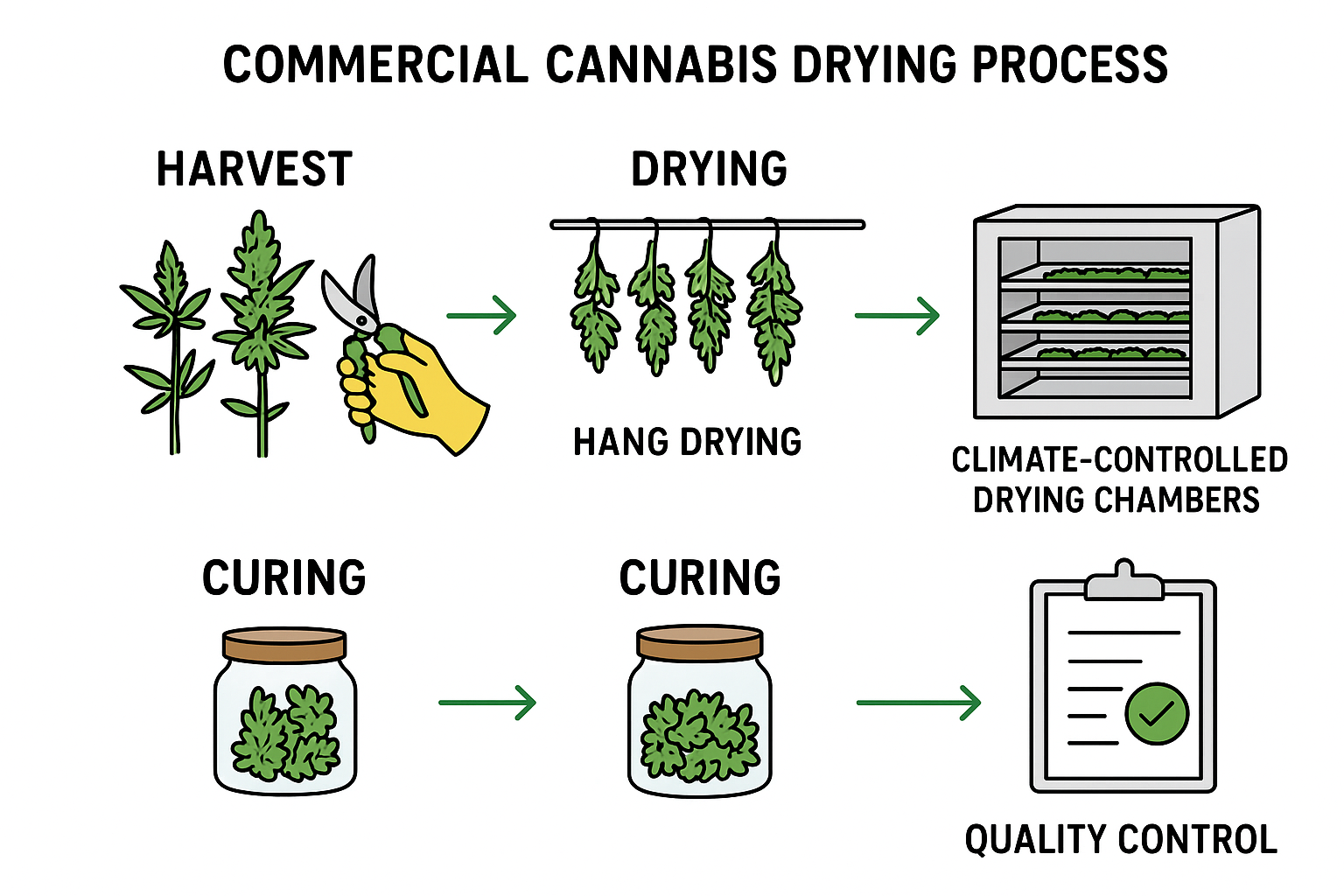Drying cannabis is a crucial step in commercial cultivation. It is not merely about removing moisture from the buds; it directly affects potency, aroma, user experience, and storability. If freshly harvested buds are stored without proper drying, residual moisture creates an ideal environment for mold and bacteria to grow. This not only ruins the flower's appearance but can also degrade active compounds, directly impacting product efficacy and safety.
The drying process is also tightly linked to cannabis flavor and mouthfeel. Terpenes — the aromatic compounds that give cannabis its distinctive scent — are highly volatile during drying. Drying that is too rapid or too hot will drive off these terpenes and reduce overall flower quality. By scientifically controlling temperature and humidity so that buds dry slowly and are subsequently cured, terpenes can be stabilized and the flower's flavor and mouthfeel enhanced, making the final product more desirable.
Beyond aroma and potency, drying also determines burn characteristics and overall consumption experience. Overly moist buds burn unevenly and produce harsh smoke, whereas properly dried buds burn evenly and deliver a smoother experience — an important factor for both smoking and downstream processing.
From a commercial standpoint, the value of proper drying is obvious. A qualified drying process ensures product consistency and traceability, increasing market competitiveness. Properly dried cannabis can be stored long-term without spoiling, retains potency and desirable flavor, and thus commands higher prices and strengthens brand reputation.
Therefore, drying is not just a technical step in cultivation; it is a key stage for ensuring product quality, market value, and consumer satisfaction. Commercial growers who neglect this stage risk loss of active compounds, diminished flavor, and potentially large-scale product losses. Scientific and well-managed drying maximizes both economic returns and quality assurance.
Below we outline the standard handling processes for drying cannabis in a commercial environment.

I. Harvest and Initial Processing
In commercial cannabis production, harvesting is more than just cutting plants — it marks the end of the growth cycle and is a pivotal moment for product quality and market value. Growers closely monitor trichome development toward the end of flowering because these resin glands influence aroma and potency and indicate optimal harvest timing. When trichomes shift from clear to milky and begin to show slight amber hues, active compounds have typically reached an ideal balance; harvesting at this point best preserves flavor and potency.
After harvest, trimming becomes the next focus. Commercial operations choose trimming methods based on scale and processing goals. Wet trimming is performed immediately after harvest while buds still retain substantial moisture; workers remove excess leaves at this stage. Wet trimming significantly shortens drying time and reduces mold risk, especially valuable in large-scale facilities due to operational efficiency. It also makes bud contours more visible to workers, resulting in a cleaner, more consistent final appearance.
By contrast, dry trimming follows a more deliberate pace. Plants are hung whole to dry before trimming away leaves after moisture loss. Although slower, this method better preserves bud structure and allows aroma to develop more gradually. Dry trimming is common in small-scale, craft operations that prioritize manual quality and fine control.
In commercial systems, efficiency and risk control are paramount, so wet trimming is the preferred method for most enterprises. Standardized procedures and supportive equipment enable large-volume processing in a short time and reduce the risk of mold from improper drying conditions. Whatever method is chosen, the core is timing — harvesting at the peak of maturity and ensuring each subsequent step supports final quality.
Harvest timing: Harvest near the end of the flowering stage when trichomes reach desired maturity.
Trimming (Trimming types):
Wet Trim: Remove large and fan leaves immediately after harvest to reduce drying time and mitigate mold risk.
Dry Trim: Hang whole plants to dry first, then trim; preserves bud integrity but prolongs the drying process.
Commercial growers commonly adopt wet trimming for efficiency and to minimize mold risks during drying.
II. Drying Environment Control
The drying stage in commercial cannabis production is often the decisive factor for final quality. Although plant metabolic activity has largely ceased at harvest, internal chemical changes continue — moisture evaporation, terpene retention, and THC stabilization all depend on a carefully controlled environment. For commercial operators, drying is not passive; it is a precision-controlled process.
Professional facilities provide dedicated drying spaces — "dry rooms" or "climate-controlled chambers" — that are tightly controlled like laboratories. Each operation aims to slowly and uniformly remove excess moisture without damaging bud structure or aroma. To accomplish this, temperature is typically stabilized near human comfort range to avoid terpene volatilization from excessive heat while preventing slow drying (and mold) from being too cool.
Humidity control is equally nuanced. Excess humidity can make tightly packed buds damp and susceptible to rot; too little humidity can cause rapid surface drying while the interior remains moist, creating "case hardening." Commercial operators use humidity control systems to maintain a gentle, even evaporation so moisture migrates from the inside out, producing buds that are dry yet pliable rather than brittle.
Airflow is deliberately engineered. Ventilation systems avoid strong direct drafts; instead they create a mild, continuous air exchange that allows each bud to "breathe" — preventing trapped moisture while avoiding wind that might strip trichomes. The space maintains a subtle dynamic equilibrium: slow airflow, gradually decreasing temperature and humidity, and aroma concentrating in the dark.
Light exposure is strictly minimized. Cannabinoids and terpenes are sensitive to light-induced degradation, so drying rooms remain virtually dark with only brief task lighting when necessary. For large producers, stringent environmental control is about consistency: ensuring every batch cures in the ideal microclimate so each bud completes its final "maturation" before reaching the market.
Typical commercial drying parameters:
Temperature: 18–22°C (64–72°F)
Relative Humidity (RH): 50–60%
Airflow: Mild circulation; avoid direct strong winds to prevent bud drying and trichome loss
Light: Dark or minimal light to prevent THC degradation
Commercial drying typically uses purpose-built dry rooms or climate-controlled chambers to ensure uniform conditions across batches.
III. Drying Methods
In commercial operations, drying is not only the start of preservation but a formative stage for flavor and quality. Different drying methods reflect differences in scale, production philosophy, and capital investment. Regardless of method, the goal is the same: control moisture removal while preserving bud shape, aroma, and chemical constituents.
Hang Drying (Traditional):
Whole plants or trimmed branches are hung upside down on drying racks so air moves slowly through the canopy, removing moisture while flavor profiles develop. This method is favored by growers seeking premium hand-crafted quality because buds retain their original structure and density. However, it requires significant space and time — typically 7–14 days in a dedicated drying room.
Rack Drying:
Trimmed buds are laid on mesh trays and stacked in racks — a space-efficient method aligned with industrial needs. Air circulates between layers, removing moisture without agitating bud position. For mid-to-large growers, rack drying balances efficiency and quality. Modern systems may incorporate per-rack temperature and humidity monitoring to ensure uniform drying and avoid variation from air stagnation or thermal gradients.
Climate-Controlled Drying Chambers (Industrial Automation):
At industrial scale, drying is often fully automated. Climate-controlled drying systems precisely regulate temperature, humidity, and airflow, with programmed circulation cycles. These systems deliver consistent, high-quality drying with minimal manual labor, enabling rapid processing of multiple batches. Air filtration and cleanroom-like controls further enhance product safety and purity, helping meet medical or export standards.
These three methods trace a trajectory from artisanal to industrial approaches: hang drying emphasizes natural flavor development, rack drying optimizes space and throughput, and climate-controlled chambers signify precision, standardization, and scalability. Each method aims to let buds complete their transition from plant to product at an appropriate pace.
Summary of common commercial drying methods:
Hang Drying: Even drying; preserves bud integrity. (Space- and time-intensive; ~7–14 days)
Rack Drying: Space-saving; multi-layered trays enhance airflow. Often uses adjustable humidity/temperature racks.
Climate-Controlled Chambers: Automated control of temperature, humidity, airflow; high efficiency and consistent results. Often paired with filters to prevent mold and particulate contamination.
IV. Drying Time
Cannabis drying is not simply a matter of setting a timer; it's a subtle interplay between environmental conditions and the plant's own physiology. For commercial growers, drying time is determined by the dialogue among air, stems, and buds rather than the calendar. As a plant transitions from verdant growth to fragrant, textured dry flower, each hour matters to the final quality.
Generally, commercial drying takes 7–14 days, but this is a guideline rather than a hard rule. Bud density is the primary factor: dense, heavy buds require more time for internal moisture to migrate outward; airy, fine buds may reach ideal dryness in a few days. Stem thickness matters too: thick stems retain water longer, while thin stems become brittle more quickly.
Yet environment remains the most critical influence. Temperature, humidity, and airflow balance determine drying speed and uniformity. Overly dry air can cause the bud's exterior to desiccate while interior moisture lingers — a condition that raises mold risk during storage. Conversely, overly humid conditions slow drying and encourage microbial growth. Professional growers therefore rely on instrumentation rather than elapsed time alone: hygrometers and moisture meters are indispensable tools to judge progress. Drying should typically end when buds reach approximately 10–12% moisture content, balancing burn performance and terpene preservation.
Ideally, a bud will feel dry to the touch but retain slight springiness; when a small stem snaps, it should make a crisp sound without shattering into powder. This is the perfect drying point. For commercial operators, this assessment blends technical measurement with experienced sensory judgment — honed through observation, adjustment, and patience. Success is not about speed but about finding the fine line between dehydration and maturation.
Factors affecting drying time: bud density, stem size, drying environment.
Typical target: 7–14 days to reach standard dryness, indicated by:
Buds that feel dry but not brittle.
Small stems that snap cleanly rather than crumble.
Final moisture content around 10–12%, monitored with hygrometers or moisture analyzers.
V. Subsequent Curing
Drying does not end the journey for cannabis — curing is where flavor, aroma, and burn quality are truly refined. For commercial growers, curing is both a continuation of science and an art. It is more than storage; it is a controlled, slow "breathing" process that allows the plant to complete its biochemical transformations in a tranquil microenvironment.
Dried buds are gently placed into sealed containers, typically glass jars or purpose-built sealed plastic bins for large-scale production. The sealed environment lets residual internal moisture redistribute, softening texture and stabilizing aromas. Enzymes and chemical reactions within the bud continue to break down sugars and chlorophyll — the essence of curing. Under-cured cannabis may look fine but often retains a grassy, chlorophyll-like flavor; properly cured flower displays fuller aroma, smoother smoke, and improved mouthfeel.
Commercial curing favors scientific control over artisanal instinct. Growers set temperature and relative-humidity curves tailored to batch, cultivar, and drying history. They also periodically "burp" containers — briefly opening them to release accumulated moisture and introduce small amounts of oxygen. This practice prevents anaerobic conditions and mold growth while allowing desirable transformations to continue.
Curing duration varies: 2–8 weeks is common, though premium producers may cure longer. Each increment of time adds complexity to aroma and smoothness. For high-end commercial producers, the waiting is intentional: depth of aroma, rounded flavors, and even burn are all refined during this phase.
Ultimately, well-cured cannabis is not only more appealing sensorially but also chemically more stable — THC and terpenes are better preserved. Such products command higher consumer preference and reflect a mature, meticulous production system. Curing is the final push that elevates cannabis from "good" to "exceptional"; professionalism lies in enabling every jar to complete its perfect breath.
Curing process summary:
Place dried buds into sealed containers (glass jars or sealed bins).
Periodically open containers (“burping”) to release excess moisture and allow oxygen exchange.
Typical curing time: 2–8 weeks, aiding improvements in flavor, aroma, and burn.
Commercial operations often use RH/temperature-controlled curing rooms or sealed systems for large-scale curing.
VI. Quality Control
In commercial cannabis production, drying is not merely moisture removal — it is a precise quality-control process. Every bud carries brand reputation and regulatory implications; thus quality control is the soul of the drying stage. Sophisticated operations avoid leaving drying outcomes to chance; they implement continuous testing and record-keeping so each drying run hits repeatable standards for safety and consistency.
Moisture management is the first line of quality control. Over-drying dissipates terpenes and reduces aroma; under-drying invites mold and irreversible losses. To prevent deviations, commercial facilities routinely test bud moisture content to ensure each batch meets the drying standard before advancing to curing. Simultaneously, mold and microbial assays are run in parallel — these tests are critical for both product safety and regulatory compliance.
Maintaining a clean and stable drying environment is essential. Professional producers implement strict sanitation regimes in drying areas, with scheduled disinfection to deter dust, pests, and microbial contamination. Air filtration and closed-loop ducting combine to create a stable, clean microclimate, ensuring buds dry under ideal conditions.
What separates commercial drying from home-scale operations is traceability. Every batch's drying parameters — temperature, RH, time, airflow, and even operator actions — are logged systematically. This isn't merely administrative; it underpins quality assurance. With robust records, producers can trace back any batch's drying and curing profile to troubleshoot issues and optimize protocols.
Quality control in commercial drying is thus not only about preventing problems; it's a pursuit of precision, reproducibility, and brand accountability. It ensures that every bud matures in a controlled, safe environment to deliver consistent aroma, texture, and experience — treating rigorous procedure as respect for product integrity.
Commercial drying quality essentials:
Regular testing for moisture, mold, and microbial contamination.
Maintain sanitary drying environments to prevent contamination.
Implement record systems to track drying and curing parameters per batch.
Conclusion
In a commercial cultivation framework, cannabis drying has evolved from a tacit craft into a highly controlled, refined process. The objective is not merely to remove water but to guide buds through a deliberate series of physical and biochemical transformations via precise temperature, humidity, and airflow control. Drying and curing are continuous, layered processes: drying determines physical state, while curing shapes chemical profiles. Together they form the foundation of final product quality.
Compared to home-scale methods, commercial drying resembles a systematic production experiment: standardization at the core, supported by automated systems and climate control to make drying repeatable and traceable. Regardless of seasonal or batch variability, producers ensure buds follow the same drying and curing curves to avoid mold and retain terpenes and flavor complexity. This scale of operation does not sacrifice craft; it amplifies consistency and safety so each batch presents identical taste and aroma on the market.
The essence of commercial drying is control — controlling the environment, schedule, and outcomes. By turning an experience-based natural process into a predictable, verifiable quality routine, commercial facilities transform the end of the plant's life cycle into the beginning of product value.
 English
English









